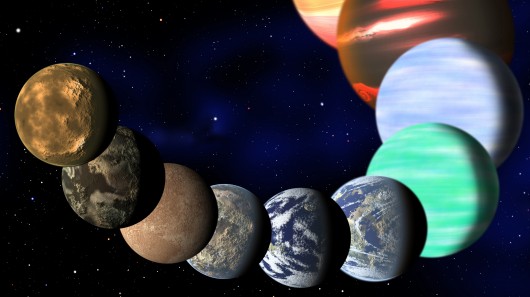Scientists say at least one in six stars has an Earth-sized planet
January 13, 2013

A recent analysis of the data gathered from the Kepler telescope has revealed that Earth-sized planets across our Milky Way are much more common than previously thought (Image: C. Pulliam & D. Aguilar/CfA)
The latest analysis of data coming from NASA's Kepler telescope has revealed that nearly all the Sun-like stars in our galaxy appear to have planets orbiting them, and that at least 17 percent of them – about one in six – are hosting a planet the size of our own in close orbit. Because the Milky Way is estimated to contain some 100 billion stars, this means that our galaxy alone could have at least 17 billion Earth-sized planets, some of which may harbor the conditions for life.
Launched in March 2009, the Kepler telescope is detecting planets in faraway stars using the transit method – that is, detecting the periodic, tiny decrease in the amount of light we receive from a star that we can detect when a planet eclipses its own star from our observation point.
Despite Kepler's technical prowess, this method is still fairly limited. For the planet to be detected, it must happen to transit exactly between the star and our observation point. Moreover smaller planets, which block out little light, are generally harder to discern, while planets in wide orbit require, on average, a much longer observation period to be detected as they won't eclipse their star nearly as often.
After a thorough 16-month survey, Kepler was nonetheless able to identify some 2,400 planetary candidates. And now, an international group of researchers has carefully analyzed the data gathered from the telescope and concluded that only about ten percent of Kepler's planetary candidates appear to be false positives, while all the others are actual planets.
When tallying up the data and extrapolating it to our entire galaxy, accounting for the planets the transit method simply can't detect, a surprising picture emerges. Half of the stars in our galaxy appear to have a planet at least as big as our Earth in close orbit; when also including larger planets in wider orbits, the number shoots up to 70 percent. If we add to this figure the data obtained with other planetary detection techniques, it seems that nearly all Sun-like stars have planets orbiting them.
Of these stars, about 17 percent have a planet 0.8 to 1.25 the size of Earth in an orbit of 85 days or less; about 25 percent of stars have a planet 1.25 to 2 times the size of Earth in an orbit of 150 days or less; a further 25 percent of stars has a planet 2 to 4 times the size of Earth in orbit up to 250 days; and finally, only one star in twenty has a gas giant (6 to 22 times Earth's size) in an orbit of 400 days or less.
In direct contradiction with previous results, the researchers also found that there seems to be no clear relationship between the type of star and the size of the planet orbiting it. In other words, super-Earth or Earth-like exoplanets could be it orbiting nearly any star, be it a red dwarf or a Sun-like star.
Back in 2011, data from Kepler had brought astronomers to estimate the number of planets in our galaxy at 50 billion, of which 500 million would be in the so-called "habitable zone" – with the right temperature and pressure to maintain liquid water on their surface, opening the door for life to evolve.
Scientists, however, don't quite yet know exactly what the right conditions for life are. To the best of our knowledge, planets must orbit in the habitable zone, but other conditions may have to be met as well. For instance, it is thought that the presence of a gas giant (Jupiter) in our solar system could have acted as a shield against most passing asteroids, protecting the Earth's fragile biochemistry.
Kepler's ongoing mission won't help astronomers test out such theories directly but, by helping characterize the incidence of gas giants and other types of planets across our galaxy, it could help pinpoint how many solar systems virtually identical to our own are out there – a good place to start our search.
The new analysis was recently presented to the American Astronomical Society by Francois Fressin from the Harvard-Smithsonian Center for Astrophysics (CfA).
A paper detailing the research has been accepted for publication in The Astrophysical Journal.
Sources: CfA, NASA Kepler site
Copyright © gizmag 2003 - 2013 To subscribe or visit go to: http://www.gizmag.com
